Matador Network's Blog, page 416
September 14, 2022
A Southwest Pilot Threatened To Stop the Flight After So Many Passengers Were AirDropped Nudes

If you’re into sending spicy photos, there’s no shame in your game as long as everyone involved consents. That said, strangers on a plane have not done so. A recent viral TikTok shows a frustrated pilot threatening to get security involved after he received unsolicited nude photos before the flight took off.
@teighmars @robloxsouthwestair takes airdropping nudes very seriously. #AEJeansSoundOn #WorldPrincessWeek ♬ original sound – Teighlor Marsalis
The video, posted on August 25 by user Teighlor Marsalis, shows a Southwest Airlines pilot taking passengers to Cabo San Lucas, Mexico, who said if the behavior continued that people’s vacations would be “ruined.”
“So here’s the deal. If this continues while we’re on the ground, I’m going to have to pull back to the gate, everybody’s going to have to get off, we’re going to have to get security involved, and [your] vacation is going to be ruined,” the pilot said. “Whatever that AirDrop thing is — quit sending naked pictures, let’s get yourself to Cabo.”
The incident happened while the plane was on the ground but before it pulled out of the gate. A passenger reported the explicit image sent by another passenger to a flight attendant, according to Insider. Marsalis said she also received an AirDrop request but decided to ignore it.
This AirDropping tactic has a name: “cyber flashing.” According to FindLaw, cyber flashing is an all-encompassing term for sending unsolicited explicit photos online, and yes, that includes dick pics. Only Texas and New Hampshire classify cyber flashing as a misdemeanor, while California allows victims to sue if the perpetrator is over 18. Currently, Virginia and New York are working on cyber flashing laws.
The good news is if you are tempted to open AirDropped photos, your phone won’t be hacked. If you want to avoid being AirDropped, the easiest way is to change your settings to only receiving AirDrops from friends or turning it off entirely until you’re ready to use it. 
Docastaway Lets You Live Out Your ‘Survivor’ Fantasy on a Desert Island

If you’ve ever watched Survivor, you’ve probably tried putting yourself in the shoes of one of the castaways and asked yourself a few questions: could I make fire on a desert island? Could I forage for food? Could I handle the isolation? Would I stay sane without internet? Even if you answered yes to these questions, the reality of true isolation on a desert island is probably much different than you expect. Cracking open coconuts, hunting wild chickens, and building a shelter are much more difficult when life and death are on the line. And that’s the point. If surviving in a remote location were easy, accomplishing it wouldn’t be so rewarding.
For all the would-be castaways out there, or anyone who simply wants to get off the grid, there’s a company that lets you live out all your Robinson Crusoe fantasies. Docastaway helps people escape civilization and live completely alone on a real desert island for a few days or weeks without the embarrassment of creating a Survivor audition tape.
The company offers two distinct experiences: Survival and Comfort. Those who sign up for the Survival experience can expect to be whisked off to a remote location and left to find their own food, build their own shelter, and navigate the area’s rugged terrain with no help whatsoever. This isn’t a family island vacation. Many who choose this option go completely solo for the true castaway experience. The Comfort option, by contrast, comes with more comfortable amenities. Depending on the destination, these could include showers, bungalows, and bedding, and you certainly won’t be foraging for your own food. Whichever experience you choose, you’re guaranteed to be completely alone and miles from the nearest tourist.
Rather than selling “survival” experiences, Docastaway is really selling a sense of isolation, explains Alvero Cezero, founder of Docastaway.
This interview has been edited for length and clarity.
Matador Network: Explain the concept behind Docastaway, and what inspired the ideaAlvero Cezero: When I was eight years old, I used to spend my summer holidays with my family in a fishing village near Malaga, Spain, where there are plenty of secret coves. I used to escape there with my own little floating raft (without my parents’ permission, of course), and on a little secret cove called Calaiza I experienced for the first time what it felt like to be a castaway.
When I was 19, I wanted to be a real castaway and set about finding help to fulfill my dream. I searched online (it was the beginning of the internet) but I didn’t find anything, anybody, any organization — nothing offered this unusual enterprise. Then, in 2003, I decided to do it myself and go on a real desert island for the first time on the remote archipelago of Andaman and Nicobar in India. From then on, I dedicated the rest of my youth to exploring untouched archipelagos in different continents. When I finished my university studies, knowing that it was impossible for me to spend the rest of my life working in an office, I did another search on Google but still there wasn’t any company offering castaway experiences. So as I was sure there were more people like me in the world, I decided to create Docastaway.

Photo: Docastaway
How do the two options (Survival and Comfort) work?We have islands where there is nothing built that are perfect for those who wish to test their survival skills for a few days or weeks. We’ve also got desert islands where a hut or bungalow has been built, some of them with showers and even electricity. In both options the feeling of isolation is guaranteed, and in case of emergency we will go in for rescue in a few minutes or hours depending how far is the island from the nearest civilization.
What kinds of people typically sign up?Forty percent of our clients are solo castaways, 40 percent are couples, and 20 percent are smaller groups of two or three friends. In Comfort Mode, 95 percent of the clients are couples. Our clients are from all over the world, but mainly from the United States, United Kingdom, Spain, Netherlands, Germany, and Switzerland. Ninety-five percent of our castaways are from North America and Europe.
What experience are they looking for that they can’t get anywhere else?People are looking to be completely alone on a remote desert island. Achieving a feeling of true isolation is almost impossible these days, and we guarantee that feeling.
How do you identify locations that will be used in the experience?An island is suitable if enough isolation can be achieved. It’s possible to find a good team to prepare the experiences, a local government that allows and supports our activities, and whoever owns or oversees the island to respect our contracts. We also prioritize convenient logistics and reasonable travel costs, so guests aren’t physically and financially drained upon arrival.
What do clients get on the Survival experience, and what must they do for themselves?The Survival experience is normally for those who wish to test themselves, and they normally go solo. For many, it’s a once in a lifetime experience. Repeating clients typically choose a Comfort Mode Experience after a Survival Mode.
Survival castaways need to forage for their own food (mainly coconuts, crabs, and fish) and make their own shelter to cover from the rain. Most of them choose to bring a machete with them and also lighters. They sometimes bring backup drinking water so they can feel more secure. But a few of them decide to go with nothing, and in case they cannot handle it they can call us and we visit them to bring new tools or supplies.

Photo: Docastaway
Is the Survival experience usually what clients expect, or is it tougher?Surviving on a tropical island is not too difficult, especially when you only go for a few days. Tropical desert islands can have plenty of food and liquids. Moreover, our body can survive without water or food for that time. But we did have clients in the past who struggled — especially for those who don’t have much resilience. They call us and we go to take them back to civilization earlier.
Any horror stories of people quitting early?Luckily we haven’t really had any horror stories. But we did have many people quitting before their last day. For example, we have two Canadian guys who got so scared to see a snake in the entrance of their tent in the middle of the night when they wanted to go out to urinate that they called us asking for a rescue and they didn’t come up from their tent until we were there.
Some clients got seriously sunburnt and they wanted to come back. Others got stomach problems. Others got trapped on a rock while fishing during high tide. Other clients just got too scared or lonely of never ending nights in the dark. Others got too hungry.

Photo: Docastaway
How do you keep people safe, while also giving them enough space to go it alone?Clients are fully responsible for anything that happens during their stay. They are aware of the risks and they know that they are completely alone. We only commit to go for rescue in a certain amount of time depending on the island.
This Epic Burning Man Drone Show Blew Everyone Out of the Water This Year

Burning Man is a sensory overload, jam-packed with innovative artworks, the brightest of them best viewed at night, all of them temporary. This year, at Burning Man 2022, there were more artworks than ever, and it felt impossible to see them all.
But then I looked up from my LED-strung bicycle as I pedaled across the nighttime desert and gasped at a massive art piece that was impossible not to see. There in the black sky was the best of Burning Man art — its cutting-edge, nocturnal, and ephemeral qualities — cranked up by a thousand.
A thousand drones, that is.
Each night at Burning Man 2022, Amsterdam-based Studio Drift illuminated the sky with its astonishing drone art — shining stars in a multitude of colors gracefully morphing from one giant object into another. An ominous mask-like face overlooking Burning Man’s Playa spun slowly, before becoming a grand blue bird gently flapping its wings.
@explorerbaee #burningman #burningman2022 #burningmanvibes #dronevideo #drones #burningmanart #droneshow ♬ Cornfield Chase – Hans Zimmer
In the most remarkable Burning Man drone show, purple and blue lights danced in an enormous whirl that seemed to create a pair of legs out of glittery dust and then an entire being — a 100-foot-tall version of this year’s Burning Man effigy.
Then a white Stetson hat appeared, and the giant Sky Man put it on — and there was Larry Harvey, the Burning Man founder who passed away in 2018. He raised his massive sparkly arms, gently laid himself down, spun slowly, and dissolved into a myriad of stars wafting towards Heaven.
Or he was dissipating back into our reveries, as this year’s theme was “Waking Dreams.” This year’s Burning Man drone show couldn’t have been more fitting. Like the rest of Burning Man, it was the stuff of our imaginations brought to life. 
This Quiz Helps You Find the Perfect Backpack for the Style of Traveler You Are

Having the right backpack for travel is essential to keeping yourself together on the road. Thing is, there are so many types of travel backpacks that choosing the right one for you can be quite confusing. That’s why Matador created this quick quiz — by the end, you’ll know what type of backpack you need and we’ll even offer a few suggestions to choose from.
After you take the quiz below, peruse our travel backpack reviews and suggestions based on your results:
Question 1 of 7 Will you be spending most of your time outdoors or in cities? In the great outdoors In cities Question 2 of 7 How long will you travel? Less than one week Between one week and two months A full season Indefinitely Question 3 of 7 Will you use this pack for frequent trips? You know it! Meh, I only travel once a year Question 4 of 7 Do you pack heavy or light? I bring so much stuff! I bring what I need. Question 5 of 7 Do you consider yourself a minimalist? Yes No Question 6 of 7 Will you be working remotely while on the road? Yes Yes, but I also plan to do a lot of adventuring No Question 7 of 7 What is your favorite travel movie? A Map for Saturday Up In The Air Wild On The Road EuroTrip Submit for your score More Trivia (function () { window.onload = function () { var totalProgress, progress; const circles = document.querySelectorAll('.progress'); for (var i = 0; i < circles.length; i++) { var percentageComplete = circles[i].parentElement.getAttribute('data-percent'); var strokeDashOffsetValue = 100 - (percentageComplete * 100); var progressBar = $(".js-progress-bar"); progressBar.css("stroke-dashoffset", strokeDashOffsetValue); circles[i].querySelector('.bar').style['stroke-dashoffset'] = strokeDashOffsetValue; } } })(); var quizChoices = []; const questions = document.getElementsByClassName("mn-quiz__question"); for (let i = 0; i < questions.length; i++) { quizChoices[i] = '-'; } function clickChoice(event) { const button = event.currentTarget; var mnQuizQuestion = button.dataset.mnQuizQuestion; quizChoices[mnQuizQuestion] = button.dataset.mnQuizChoice; for (const button of buttons) { if (button.dataset.mnQuizQuestion === mnQuizQuestion) { button.classList.remove('active'); } } button.classList.add('active'); } function submitQuiz() { var formatUrl = 'choices=' + quizChoices.join('_'); var url = window.location.href; if (url.indexOf('?') > -1) { url += '&' + formatUrl } else { url += '?' + formatUrl } window.location.href = url; } const buttons = document.getElementsByClassName("mn-quiz__question__choice"); for (const button of buttons) { button.addEventListener("click", clickChoice); } const submitButton = document.getElementById("mn-quiz__submit"); if (submitButton) { submitButton.addEventListener("click", submitQuiz); }
The Perfect Backpack for Every Type of Traveler, From Hostelers To Hikers This Small Backpack Is the Only Travel Pack an Efficient Packer Needs Tortuga Setout 45L Is the Best Travel Backpack for Your Money The best Patagonia backpacks for travelers
The Best Foods To Eat at Dollywood, a Theme Park for Southern Comfort Food

Nestled in the Great Smoky Mountains of East Tennessee, Dollywood is a timeless theme park that exudes charm. While it might be known for music, Dollywood food is just as notable.
Helmed by its dreamer-in-chief Dolly Parton — who grew up nearby — the park embraces its stunning location. Here, Southern hospitality is an attraction itself as you enjoy standout entertainment from talented musicians, including Parton’s family members. Great music is paired with world-class attractions, including globally recognized roller coasters. But you won’t get the full Dollywood experience unless you also try the park’s standout cuisine: Dollywood food includes legendary dishes like the pull apart cinnamon bread and pulled pork sandwich.
Once a regional destination, the theme park has since grown to attract guests from all over the world – and the Southern comfort food offered at the park is one reason why. The park’s incredible culinary offerings highlight mountain culture and the Southern way of life. Dollywood food is a glimpse into the area’s rich cultural contributions — and there are even some recipes from Dolly’s personal kitchen. From award-winning barbecue to unexpected sweet delights, Dollywood trades the theme park standards of hamburgers and hot dogs for more inspired options.
As an avid theme park goer for over three decades, I can say with authority that Dollywood shines with some of the best food at any park in the country. In addition to eats served all season long, the culinary team has upped the ante in recent years with food festivals and specialty wine dinners at the neighboring resort. You’ll come for the roller coasters and concerts, but stay for the food.
The best Dollywood food you need to try on your next visitPulled pork sandwich
Photo: Carly Caramanna
Dollywood’s most famous dish, the award-winning pulled pork sandwich, is a rite of passage for any visitor. Served from Hickory House BBQ, an unassuming counter service location, the sandwich is piled high with incredibly tender and flavorful BBQ pork. Smoked in-house, it’s gently doused with just the right amount of sweet and tangy barbecue that compliments the meat. Whether enjoying it for your first time (or hundredth) it is a shining example of Dollywood’s ability to flex its culinary muscles.
Where to find it: Hickory House BBQ
Stone SoupA recipe direct from Dolly’s life, stone soup is a rich combination of tomatoes, okra, potatoes, onions, and salt pork. The recipe was created by Parton’s mother and a favorite of Dolly and her 11 siblings when growing up nearby. With an earthy taste, it’s a hearty soup with origins that can be traced back centuries. The gluten-free dish is served during dinner service at Song & Hearth at Dollywood’s DreamMore Resort.
Where to find it: Song & Hearth at Dollywood’s DreamMore Resort
Cinnamon bread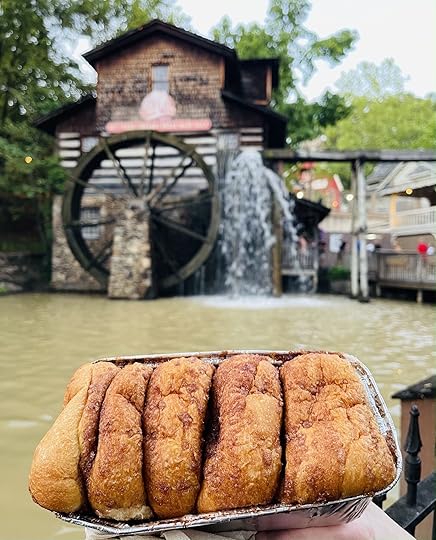
Photo: Carly Caramanna
I can confidently attest that Dollywood’s other most sought-after item is worth the hype. The park’s famous cinnamon bread is a tantalizing combination of margarine and cinnamon that’s baked to golden perfection for 28 minutes in a customized oven. Served in a loaf that’s pull-apart style, it’s pillowy soft with each bite.
The Grist Mill exclusively serves the cinnamon bread (though you can find it at a couple other spots around the park); the bakers ferociously prepare up to 1,700 loaves a day for the crowds that gather outside the bakery. I highly recommend dipping the bread in apple butter and icing, too.
Where to find it: Grist Mill, Spotlight Bakery, Dollywood’s DreamMore Resort
Dolly’s banana puddingFor a glimpse into life for Dolly growing up, Granny Ogle’s Ham ‘n’ Beans offers up Dolly’s Banana Pudding, a recipe created by her mother. The delicious combination of scratch-made vanilla pudding, banana slices, and vanilla wafers is made even sweeter by its story. Dolly has shared that money was tight for the family and a local store would tip the Parton parents off when bananas were nearing spoiled and offered at a discounted price. It’s creamy and rich, but remarkably light.
Where to find it: Granny Ogle’s Ham ‘n’ Beans
Southern-style breakfast
Photo: Carly Caramanna
Located just next door to Dollywood, the DreamMore Resort is the property’s flagship, full-service hotel. Its signature restaurant, Song & Hearth, is dishing out traditional Southern eats, including the Southern-style breakfast buffet, open to both hotel guests and the public. As you fuel up for a park day, you can enjoy breakfast specialties like prime rib beef hash, stone-ground grits, and salty country ham. The sausage gravy and biscuits are a must-have on your plate as this beloved Southern staple is executed to perfection here.
Where to find it: Song & Hearth at Dollywood’s DreamMore Resort
Ham ‘n’ BeansAn unexpected theme park find, Granny Ogle’s Ham ‘n’ Beans welcomes guests onto its porch for a traditional Southern meal. Granny Ogle’s signature pinto beans, or as they are more commonly called in the South, soup beans, are paired with savory pulled pit ham, and bright turnip greens. This dish hits all the right notes of salty and savory — and was a favorite of Dolly’s when she was growing up.
Where to find it: Granny Ogle’s Ham ‘n’ Beans
25-pound apple pie
Photo: Carly Caramanna
The scent of baked goods flows through the air at Dollywood’s entrance beckoning hungry guests inside the Spotlight Bakery. With delicious treats, including freshly prepared cookies and cinnamon rolls, it’s the 25-pound apple that piques the interest of many. Staggering in size, each pie is made with around 20 pounds of apples. Cooked in a giant cast iron skillet, the result is buttery and sweet. Dollywood shares that they sell on average several dozen of the full-size versions a year, but individual slices are available every day and serve up to four people.
Where to find it: Spotlight Bakery
Meatloaf StackerThe meatloaf stacker is Southern comfort food at its best. Served at Granny Ogle’s Ham ‘n’ Beans, this Dollywood signature dish is decadent. A slice of buttercrust white bread is loaded with mashed potatoes and a piece of homemade tomato glazed meatloaf. It’s topped with even more mashed potatoes and drizzled with savory brown gravy.
Where to find it: Granny Ogle’s Ham ‘n’ Beans
Pork rinds
Photo: Carly Caramanna
Dollywood doesn’t just serve excellent pork rinds but makes them right before your eyes. The snack is prepared using fresh pork rinds that are deep fried to a golden hue. Captivated onlookers can hear the pig skins sizzle and pop as batch after fresh batch is prepared within minutes at an open-air stand. Delicious as is, they also come tossed in BBQ seasoning adding a bit of smoky sweetness to the mix.
Where to find it: Craftsman’s Valley. Also available from Country Cookers’ Kettle Korn, Midway Market, Hickory House BBQ, and Mr. Jerry’s Sit & Sip Refreshment.
Creamy soup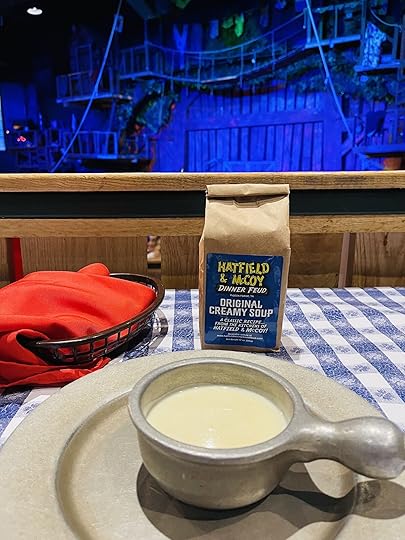
Photo: Carly Caramanna
When the sun sets on Dollywood, the fun continues at several Dollywood-owned dinner shows. A dying breed across the country, these immersive experiences where food meets performance are alive and well in the Smoky Mountains. Hatfield & McCoy’s Dinner Feud is a homestyle feast where crispy fried chicken is served alongside an entertaining performance, but the must-have here is their Southern-style creamy soup. It’s a simple soup with a bold, peppery taste, but it’s become so popular that locations throughout Dollywood now sell an at-home mix so you can take it home.
Where to find it: Hatfield & McCoy’s Dinner Feud 
Can You Guess What These Funny British Slang Phrases Mean?

While Britain is comprised of England, Wales, Scotland, and Northern Ireland and each of these countries have their own sayings and expressions, they also have some common ground when it comes to slang. And Americans coming to Britain, whether they visit London, Cardiff, Edinburgh, or Belfast, may be shocked to see that despite speaking English, there’s plenty they can’t quite understand. British slang is ubiquitous, colorful, and not self-explanatory — you have to learn it to understand it.
See if you’re ready to tackle a conversation with the locals by taking this British slang quiz. If you’re not quite up to the task, you can brush up on your British sayings beforehand. 
These Albuquerque Airbnbs Let You Capture the City’s Southwest Charm

There’s much more to Albuquerque, New Mexico, than ballooning. What the Sandria Mountains offer in terms of hiking and views, Old Town marches with its adobe architecture, cultural centers, and food. When you’re not watching for cranes at the Bosque del Apache Wildlife Reserve or tracking down Breaking Bad filming locations, you can recharge at one of Duke City’s dreamy villas. We’ve rounded up the best of the Airbnbs in Albuquerque.
Traveling to the Southwest? Check out Matador’s Southwest accommodations guides:11 Phoenix Airbnbs With Luxury Pools, Putting Greens and Artsy VibesStay near Garden of the Gods and Pikes Peak at these Colorado Springs AirbnbsThe best Airbnbs in Denver for beer, 420, and mountain culture
We hope you love the Airbnb Albuquerque vacation rentals we recommend! Just so you know, Matador may collect a small commission from the links on this page if you decide to book a stay. Listed prices are accurate as of the time of publication.
Cool down at these Albuquerque Airbnbs with a poolAlbuquerque Airbnbs in Old TownMost luxurious Albuquerque Airbnbs in Nob HillBest Uptown Albuquerque AirbnbsAlbuquerque Airbnbs in NE HeightsCool down at these Albuquerque Airbnbs with a pool3,200 feet with pool, hot tub, and billiards
Photo: Airbnb

Photo: Airbnb
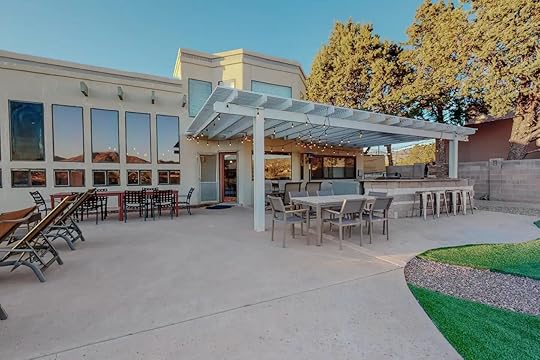
Photo: Airbnb

Photo: Airbnb
Located in Four Hills, this Airbnb Albuquerque with a hot tub, pool, and sun terrace overlooks the East Mountains. The yard is fitted with an outdoor pizza oven and grill – awesome for leisurely lunches and barbecues. It’s a 15-minute drive to the airport and 10 minutes to Old Town. Modern internal spaces benefit from natural light and a games zone. The host can provide additional services and equipment such as childcare and cleaning.
Sixteen guests, six bedrooms
Price: $540 per night

Photo: Airbnb

Photo: Airbnb

Photo: Airbnb

Photo: Airbnb
This North Valley Albuquerque Airbnb with a pool is private and peaceful with lavishly appointed interiors. Bedrooms are prepared with plush fabrics and soothing pieces of art. The master suite bathroom has a dual shower and a free-standing soaking tub. You’ll find the pool – with a volley net for added fun – in the fully-fenced yard as well as a brand new spa tub and cornhole equipment.
Eight guests, four bedrooms
Price: $550 per night

Photo: Airbnb
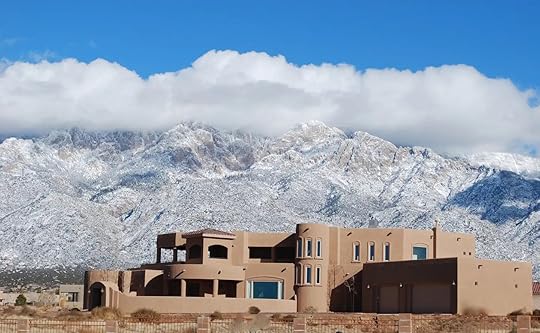
Photo: Airbnb

Photo: Airbnb

Photo: Airbnb
This astonishing Airbnb in Albuquerque’s NE Heights wraps itself around a sprawling backyard complete with a pool, hot tub, in-ground trampoline, and covered seating. Find the “hidden staircase” recreation room stocked with a giant chess board, ping pong table, shuffleboard, and family games. Upper-level decks are perfect for a yoga or meditation session with a view of the mountains. Rooms are cozily outfitted with high-quality linens. You’ll need to form an orderly line to take turns in the jetted tub with ornate tiling.
Sixteen guests, seven bedrooms
Price: $1,300 per night

Photo: Airbnb

Photo: Airbnb

Photo: Airbnb

Photo: Airbnb
The Desert Compass is a centrally located luxury resort with six themed suites. Earth brick buildings are surrounded by lush gardens while decor captures the essence of the desert. This listing applies to the entire complex and gives you exclusive access to the facilities and cowboy pool. However, you can also book any one of the individual units via the host’s page – each has a private bathroom and kitchen. Pets are welcome at this Airbnb Albuquerque Old Town subject to prior approval.
Sixteen guests, six bedrooms
Price: $1,600 per night

Photo: Airbnb

Photo: Airbnb

Photo: Airbnb

Photo: Airbnb
Conceived for families and remote workers, this new build has ample living space, deluxe bathrooms, and a home office. Top-end upholstery and appliances ensure that your stay is comfortable and practical, while the enclosed yard is ideal for barbecues and sunbathing sessions. Airbnb Albuquerque monthly discounts apply to this stylish property for small groups steps from downtown and Old Town.
Five guests, three bedrooms
Price: $540 per night
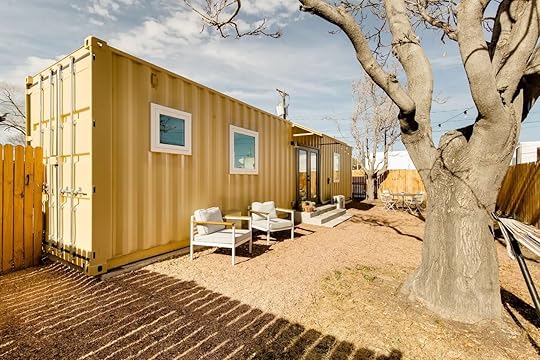
Photo: Airbnb

Photo: Airbnb
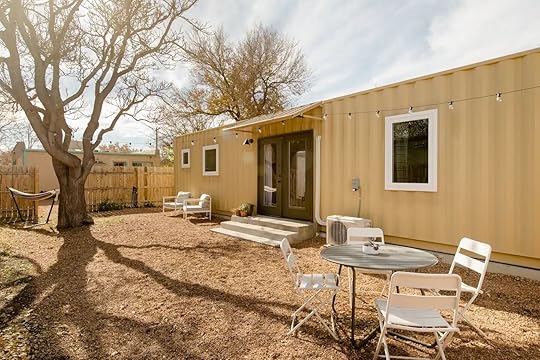
Photo: Airbnb

Photo: Airbnb
This truly unique Albuquerque Airbnb occupies a custom-built shipping container right off Historic Route 66. The living quarters have been modeled to a luxurious standard, using locally crafted furniture, art, and homeware. Though compact, the bathroom comes with the bonus of a bath and the host permits dogs to stay. Step outside with your morning coffee and dine al fresco under the NE sun.
Two guests, one bedroom
Price: $250 per night

Photo: Airbnb

Photo: Airbnb

Photo: Airbnb

Photo: Airbnb
This sumptuous Spanish-style villa sits on a one-acre plot of land less than a 10-minute drive from the airport in the historic Nob Hill neighborhood. Newly available to the Albuquerque Airbnb scene, there is no other building in town quite like it. The facade of the main unit is fronted by ornate columns and covered balconies. Equally elaborate interiors are dressed with antiques, tapestries, and a statement piano.
Sixteen guests, six bedrooms
Price: $935 per night

Photo: Airbnb

Photo: Airbnb

Photo: Airbnb

Photo: Airbnb
New to the market, this Airbnb Albuquerque with a hot tub, yard games, and a fire pit is perfect for small groups and families. Besides the cheerful backyard, the immaculately furnished property has an indoor games room for chillier fall and winter nights. The Uptown neighborhood is convenient for Old Town, Balloon Fiesta, and the mountains.
Six guests, three bedrooms
Price: $300 per night

Photo: Airbnb

Photo: Airbnb

Photo: Airbnb

Photo: Airbnb
Swimming is on the table year-round at this Airbnb Albuquerque with a pool! The indoor swim space is heated and affixed to a poolside bar. Slide the doors open and you’ll find a generously sized backyard enclosed by trees with seating and a fire pit. Further recreational perks include the billiards table and free use of the provided mountain bikes. The kitchen is a chef’s dream, with just about every utensil you can imagine and a skylight over the island.
Eight guests, four bedrooms
Price: $425 per night

Photo: Airbnb

Photo: Airbnb

Photo: Airbnb

Photo: Airbnb
Situated at the base of the Sandia Foothills, this Albuquerque Airbnb with a hot tub is inspired by the architecture of Santa Fe. Pleasing features including arches, beams, and a curved design add warmth to this family-friendly rental. A well-stocked library is available to avid readers. The spa is placed under the sun while shaded seating is provided on the porch – both will be hugely appreciated after a day of hiking and ballooning!
Eight guests, four bedrooms
Price: $410 per night
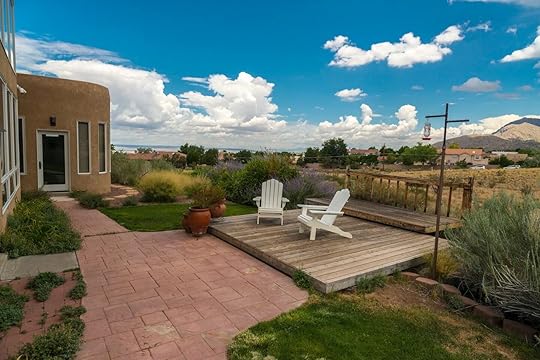
Photo: Airbnb

Photo: Airbnb
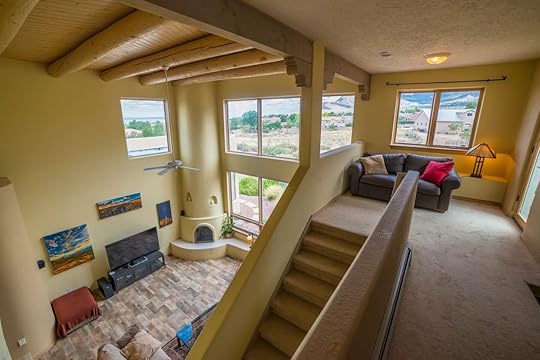
Photo: Airbnb

Photo: Airbnb
The main highlight of this Airbnb in Albuquerque’s NE Heights is the epic mountain views afforded by gigantic windows. Settle down in the lounge in front of the adobe fireplace and you can make out the peak of Sandia Mountain. Your turn to sort dinner? Strategic paneling means you can cook with a view of the foothills. The backyard is alive with greenery and frequented by hummingbirds and bunnies. Enjoy sunsets here while the fountain trickles in the background. 
Eight guests, four bedrooms
Price: $350 per night
What is the Wim Hofmethod
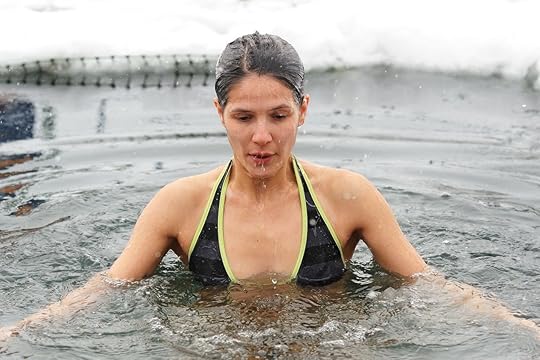
I look down to see that my toes are a striking shade of vermilion. Upon closer inspection, my feet, legs, and the rest of my body, all the way to my shoulders, match the color of my toes. I’m in nothing but my soaked bathing suit and my woolen hat dancing to an upbeat tune, and after about one minute of a fun-filled, ungraceful jig, I can feel my body getting warmer. The 12 people similarly shaking it on Que Caliente beside me must be heating up again, too — everybody has a huge smile on their face.
I had no idea that spending two minutes immersed in an ice bath could make people so ecstatic. But that’s the Wim Hof Method for you.
What is the Wim Hof Method and who is Wim Hof?
Photo: Grace Reilly
The Method, as its name indicates, was created by Wim Hof, a Dutchman well known for breaking all sorts of records related to cold exposure. The most jaw-dropping among them include swimming under ice for 215 feet and climbing Mount Kilimanjaro in nothing but shorts. Unsurprisingly, Wim Hof is commonly known as “The Iceman.” And although feats like these might seem plain insane, they are purposeful for Hof. By doing such stunts, he was proving that the method he has developed to endure and enjoy cold temperatures worked.
According to the official Wim Hof Method website, the practice is three simple pillars: breathing, cold exposure, and commitment. Every day “hoffers,” as practitioners of the method are called, have a special breathing session of about 15 minutes and expose themselves to cold water for a couple of minutes. That’s it. The hardest part of the method is to practice it every single day.
Wim Hof breathing explainedWim Hof breathing consists of three or four rounds of quickly repeated deep and full inhales and unforced exhales, interspersed with breath retentions with your lungs empty, and with your lungs full. It’s not rocket science, but it requires some concentration and a safe place. (Note that you should never practice this intense breathing technique in a body of water; the cold water immersions are a separate aspect of the method. The same goes for driving or anywhere else that could be considered dangerous).
What are the three steps of the Wim Hof method?The three steps of the Wim Hof method are breathing, gradual cold exposure, and commitment to the practice.
How do I start the Wim Hof method?Waking up with the sun is the first stage of starting the Wim Hof method. As we go on to discuss having a safe environment with people around you is a must.
Cold exposure benefitsThe cold exposure can be implemented in the form of cold showers, dips in cold water, or ice baths. There’s no need to immerse yourself in freezing waters for 15 minutes — two minutes will do the trick.

Photo: Grace Reilly
While the method is simple, the benefits are huge. Science has proven that cold therapy reduces inflammation, enhances energy levels, improves the quality of your sleep, and boosts your immune system, among other advantages. The Wim Hof breathing exercise is known to alleviate stress and improve athletic performance, but it’s also been linked to the reduction of symptoms of several autoimmune diseases, asthma, multiple sclerosis, rheumatoid arthritis, and more.
And all these scientifically proven health benefits, combined with the simplicity of the practice, and the fact that it costs nothing and requires no equipment, have not been lost on those searching for an improved quality of life. There are more people talking about the Wim Hof Method out there than you can shake a stick at. Even Gwyneth Paltrow decided to put aside vagina-scented candles for a minute to devote a full episode of Netflix’s The Goop Lab to the method. And since the episode has aired, interest in Wim Hof and the practice has skyrocketed.
I personally heard about the method from a couple of friends in their 50s who discovered it on YouTube less than a year ago and have been practicing since then. Knowing that I am a swimmer and enjoy relatively cold waters, they attempted to convince me to give it a try. But there was no way I was going to voluntarily hyperventilate on my own at home, cued in by some random YouTube video. Instead, I signed up for a Wim Hof Fundamentals Workshop. With a trained instructor by my side, I was ready to give it a shot.
What to expect at a Wim Hof workshop
Photo: jeffrey.c.sorensen/Instagram
Partaking in a Wim Hof Fundamentals Workshop costs a minimum of 90 USD (price varies) for four to five hours of instructions, which include a detailed history lesson of how the method came to be, a thorough scientific explanation of the method’s benefits, a breathing session, and an ice bath. Workshops are led by knowledgeable certified Wim Hof Method (WHM) instructors. There are workshops throughout the world, from South Africa to Singapore.
The workshop I signed up for took place on a Sunday afternoon in mid-January in the small town of Nelson, British Columbia, Canada. When I arrived that day, there were three people shoveling snow into two steel bathtubs located outside the CrossFit gym where the event was to take place. A daunting indication of what was to come.
Workshops tend to be on the small side so that each participant gets the attention they need. That Sunday, there was a diverse group of 12 of us sitting on yoga mats listening attentively to our instructor, Jeffrey Sorensen.
Jeffrey introduced himself as a paramedic, a yoga and breathwork instructor, a survivor of several near-fatal accidents and drug addiction, and, of course, a Wim Hof convert. His story of addiction and recovery through yoga was impressive, but what struck a chord with all of us was his passion and utter conviction in the method.
“I’ve been practicing the Wim Hof Method for two-three years, and every day since I started, I wake up feeling amazing,” he said from his mat, with a beaming smile and twinkling eyes that should definitely be plastered on every Wim Hof poster out there.
If someone with such a difficult past could feel amazing every single day thanks to 15 minutes of breathing and two minutes of cold-water exposure, I wanted to be in on it. I wanted to feel amazing too.
After Jeffrey led us into a short yoga sequence and explained to us the basics of the breathing technique, we were all set to try it out. But before we got started, I raised my hand and shared my anxiety with him and the group. Having experienced several severe panic attacks in my life, I had apprehensions regarding the sensations that the WHM breathing could bring forward. One video online of the popular Yes Theory Youtubers practicing the breathing technique shows one of them convulsing — an experience he later said he did not remember having.
“You can stop or slow down at any time because you’re totally in control, “Jeffery reassured me. “But know that you can be brave today — you’re in very safe hands.”
That’s all I needed to hear.
I did not know you could get high on breathing, but it turns out that you very much can. The feelings I experienced are akin to having a couple of glasses of wine on an empty stomach. I felt light-headed, giddy, and entirely relaxed.
The workshop ended with the much-anticipated cold bath. Jeffrey opened the large garage door to the outside where the tubs were waiting for us, and we were told to take off our shoes, get into our bathing suits, and organize ourselves in a circle. It was 14 degrees Fahrenheit that day. With traditional First Nations music playing loudly, we performed the “horse stance” — standing with our legs apart and knees bent as if we were riding a horse, we pushed our arms out towards their opposite sides, one after the other, in rhythm with our breath. Initially a martial art posture, the horse stance is a form of movement meditation that brings mental focus and warmth to the body.

Photo: carlos.araujo/Shutterstock
For some, going in the tub of slush was very hard. For others, it seemed easy. When my turn came, I was so focused on the task that there was no place for any thoughts other than “I’m going in now.” Jeffrey instructed me to step in and stand in the tub, then lower myself in the water. I did as told while locking eyes with him the whole time and breathing calmly, but rhythmically. I personally felt nothing unpleasant: no cold and no pain. I did find myself smiling after several seconds of immersion, as if someone had hit the pleasure switch inside my head. I stayed two minutes in the tub before Jeffrey helped me out. I wrapped a towel around myself and joined the circle again, where the rest of the group was still moving intentionally.
The group setting made the affair all the more powerful. While the workshop is a personal experience, the other participants provide support and motivation. There’s no embarrassment, pressure, or shame — just a great deal of encouragement, joy, and fun. “It’s good to practice as a group,” Jeffrey said when I met him a couple of weeks after the workshop. “The group dynamic helps you commit, and commitment is the most difficult pillar of the WHM.”
The method is so simple, accessible, and empowering that you can participate in one workshop and practice to reap the benefits for the rest of your life without spending another penny on it or learn anything more about the WHM. But, the workshop is undoubtedly a one-day “peak experience” that can be tricky for some to replicate at home alone. For those who need more support, there are other ways to get your practice going strong: a full, week-long retreat to remote, frozen Poland, with Wim Hof himself.
What to expect at a Wim Hof retreat
Photo: carlos.araujo/Shutterstock
If you can manage the steep price tags, you can dive deep into this practice by going on a trip led by Wim Hof. While they are not as intimate as the workshops (they gather about 100 participants), they last five days and are organized so that there are two expert instructors per 25 people.
The winter trips take place in Poland, on the border of the Czech Republic, near Wim’s personal house. Participants not only learn and practice the breathing technique and cold immersions but also climb the summit of Mount Śnieżka or another nearby peak in nothing but their bathing suit as another form of cold therapy. The summer trips take place in the Spanish Pyrenees and include activities such as hiking, canyoning, and white-water rafting. If you’re super keen, there’s also an expedition to the top of Mount Kilimanjaro in Tanzania that will cost you a pretty penny, but that will allow you to combine wellness and once-in-a-lifetime outdoor adventure in one trip.
Grace Reilly, a 22-year-old woman who works as a Corpsman in the US Navy Reserves, went on a Wim Hof-led trip to Poland this past January. She learned about the method a few years back while listening to a podcast and was immediately taken by the accessibility of the method. But what really sold her on it was the fact that it was grounded in science.
While Wim Hof has been the subject of many scientific experiments throughout the years, the best-known and surprising of them is the time he was injected by a team of scientists with an E. coli bacteria that should have triggered stomach cramps, diarrhea, vomiting, and a mild fever but had no effect on him. And it’s not just him who resisted the bacteria; a group of people whom Wim Hof trained with his method showed the same astonishing results.
“[After I learned about this experiment], I just became obsessed with Wim and his philosophy on life. He has such an amazing spirit to him,” Grace explains. Although she had never taken a workshop or practiced the method on her own, she was determined to learn and garner its benefits during her trip.
While the price is indisputably high for such a short trip (about 2,500 USD, flights not included), Grace believes it is well worth the money. “This trip has been such a huge dream of mine for years now […] It is a once-in-a-lifetime experience, so that is how I justified it in my head. I see this trip as an investment into my well-being. I have suffered with anxiety and depression, and one of the biggest things that attracted me about this whole method is what an impact cold water therapy has on your mental health.”
I talked to Grace both before and after her trip, and it’s safe to say that the experience exceeded her expectations.
While she was one out of 110 participants, and one of the youngest among them, Grace explains she had a life-changing experience. It was the first time she traveled solo out of the US and saw the entire trip as a journey of self-discovery.

Photo: Grace Reilly
“There were 110 of us and only 10 women, but while I was nervous at first, everyone was very welcoming, and the whole experience was extremely comfortable,” Grace recalls. I also noticed that there were more men than women in the workshop I attended, which had struck me as unusual. When I mentioned it to Jeffrey, he nodded in agreeance. “The Wim Hof Method is a modality that traditionally has appealed more to men than to women,” he explained. “Although I am hopeful that is changing with more attention in the media from shows like The Goop Lab. This practice can be very beneficial and empowering for women as well.”
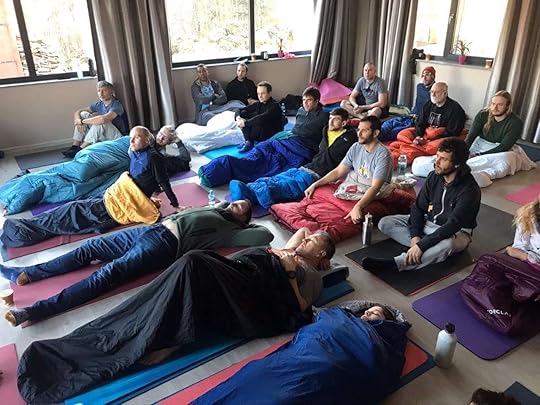
Photo: Grace Reilly
During her time in Poland, Grace practiced the Wim Hof breathing and overcame difficulties with extreme noise-related anxieties. Having 100 people breathing deeply around you is loud and distracting, and it was preventing Grace from focusing on the task at hand. But the instructors had her back. “The next day [day two of five], they brought me headphones, so I could block out the noise.” The fact that the instructors were attentive to every participants’ needs increased the feeling of safety for Grace, who was able to relax and fully immerse herself in the method.
The first day of her trip, after practicing the breathing technique a few times in her group of 10-25 people, Grace went into the cold water for one minute. While she felt pain at first, she was able to manage to stay 10 long minutes in the freezing water by the end of her trip.
The second to last day was the highlight of the trip for Grace. All 110 participants, all the instructors, and Wim Hof went on a three-and-a-half-hour hike in the snowy Karkonosze Mountains in their bathing suits. “When we were moving, it was fine, but sometimes we stopped to breathe and the wind was strong; it pierced your skin. It got really cold.” Grace mentioned that the instructors kept repeating “This is about climbing your inner mountain,” and while this might sound a little New Age-y, it resonated with Grace.

Photo: Grace Reilly
“While I was there, I kept thinking about the people in my life that the method could help. But I’m glad I went alone; it felt more meaningful for me to do this on my own.”
Since she came back from her trip, Grace has been practicing breathing daily and recently went for a dip in the ocean on a cold, rainy winter day — public “horse stance” on the beach included. She is even thinking of investing in a chest freezer which she plans to fill with ice and water for her daily cold immersions.
And if that’s not conviction and dedication right there, I don’t know what is.

Photo: Laura Reilly
Personally, a month after taking the Wim Hof Method workshop, I have stuck to the routine of cold exposure by way of daily cold showers. The practice is invigorating and truly becomes pleasurable as days go by. The breathing is the most difficult part of the method for to practice as the sensations it causes make me uneasy. But there is no doubt that the Wim Hof method has had a positive impact — I have noticed a greater clarity of mind, more energy, and less anxiety. And for just less than 20 minutes of daily practice, I’d say it’s very much worth it. 
September 13, 2022
Why Icelandic People Throw Baby Puffins Over the Cliffside Every Year

If you’ve ever wanted to marvel at adorable puffins, there are many places to do it worldwide: Labrador and Newfoundland in Canada, for example, as well as parts of the Northeastern United States like Maine, the south of France, northern Iceland, northern Russia, and Greenland. But the best place to catch these “parrots of the sea” is a trip to Iceland. Sixty percent of the world’s Atlantic puffin population resides in the country, and they come up to shore between May and August to lay their eggs. And Icelanders have had to adopt an interesting tradition of throwing baby puffins (called pufflings) off a cliff to keep that population strong.
@kyanasue I want a pet puffinI miss my Pufflings already #iceland #puffins #westmanislands #vestmannaeyjar #reykjavik #icelandtrip #traditions ♬ Love You So – The King Khan & BBQ Show
The “puffling patrol” is actual an important part of managing the puffin population when there are man-made lights present. The young birds confuse street lights with the natural signs they typically follow to the ocean. It’s not just on land, either, as pufflings in the harbor have to be rescued as well. The following morning, those who lost their way are put in boxes and thrown into the air (think of it like a running start to a jump) so they can begin their flight out toward the ocean.
If you decide to go puffin-watching, remember that even though they do not fear humans, they are still wild animals that you should respect. Don’t try to unnecessarily touch them or feed them. The cliffs that puffins reside on can be dangerous for people, as it’s easy to slip and fall on the burrows made for their eggs, which also face the danger of collapsing if you step on them. The best way to go is to approach the birds very slowly and quietly and then lie down in the grass and try not to move. And, of course, be sure to check out everything else that Iceland has to offer.
These New Jersey Airbnbs Showcase the Best of the Garden State
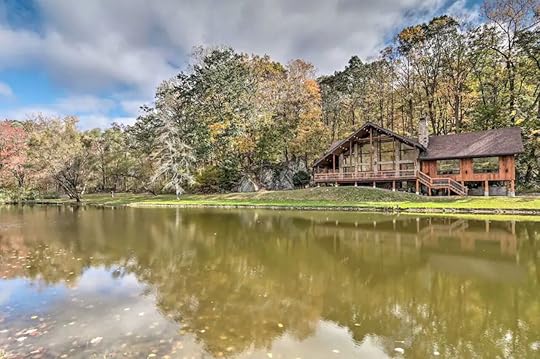
New Jersey is a state that everyone should explore and experience. If you’re more on the sun and side, there are beautiful beaches to explore. Cultural travelers love the many small towns and neighborhoods to explore. Wherever you choose, check out these New Jersey Airbnb rentals that can jumpstart your Garden State getaway.
We hope you love the Airbnb New Jersey vacation rentals we recommend! Just so you know, Matador may collect a small commission from the links on this page if you decide to book a stay. Listed prices are accurate as of the time of publication.
Airbnbs in New Jersey with a poolBeach house Airbnbs in New JerseyAirbnb Cabins in New JerseyLuxury Airbnbs in New JerseyAirbnbs in New Jersey with a poolHidden New Jersey gem with pool and gas firepit
Photo: Airbnb

Photo: Airbnb

Photo: Airbnb

Photo: Airbnb

Photo: Airbnb
Relax at this Airbnb in New Jersey to escape the hustle and bustle. This spacious home is in Cape May Court House near popular attractions. It features a spacious living room, kitchen, and three bedrooms. The outdoor area features a fenced-in backyard, an inground pool, natural gas fire pit, and an outdoor grill.
Eight guests, three bedrooms
Price: $320 per night

Photo: Airbnb

Photo: Airbnb

Photo: Airbnb

Photo: Airbnb

Photo: Airbnb

Photo: Airbnb
On your next New Jersey getaway, hang out by the lake with friends or family at this spacious lake house. This home is the perfect place to relax and regroup, and it features a spacious living area with a fireplace, a fully equipped kitchen, and seven spacious bedrooms. The lakeside home also features an enclosed porch area with a view of the lake, a hot tub, a pool, two outdoor fire pits, and a dock overlooking the lake.
Seven guests, three bedrooms
Price: $563 per night

Photo: Airbnb

Photo: Airbnb

Photo: Airbnb

Photo: Airbnb
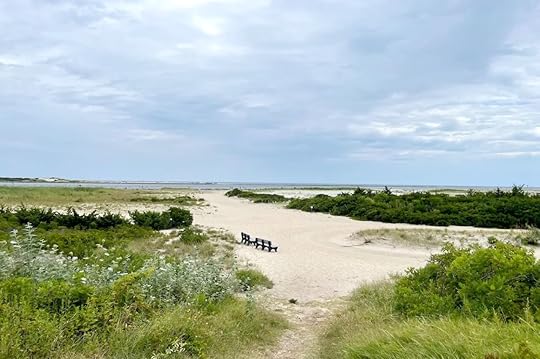
Photo: Airbnb
Enjoy this charming Airbnb New Jersey cottage near the beach. This beachside cottage is near the beach, bay, restaurants, and shops, so your itinerary will be filled with things to do. The home has a spacious open floor plan kitchen and living area. Enjoy the outdoor top deck, lounge, and sunbathe in the multiple available seating areas.
Four guests, two bedrooms
Price: $311 per night

Photo: Airbnb

Photo: Airbnb

Photo: Airbnb

Photo: Airbnb

Photo: Airbnb
Check out this cozy Avalon beach house conveniently located and walkable to town. This beach house Airbnb in New Jersey features a spacious living room and updated kitchen with quartz and granite countertops and stainless steel appliances. There is a sliding door in the kitchen that goes to the outdoor deck area and is perfect for watching the sunset.
Six guests, three bedrooms
Price: $260 per night

Photo: Airbnb

Photo: Airbnb

Photo: Airbnb
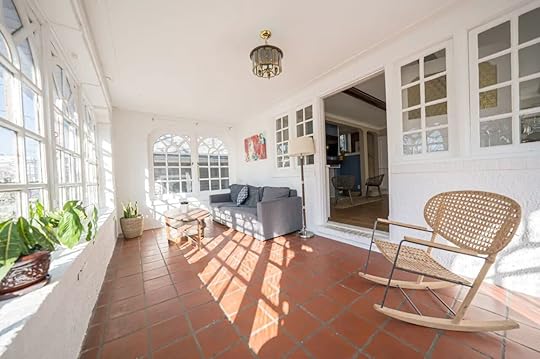
Photo: Airbnb
Here is the perfect home for a family or friend’s vacation. This spacious beach home is in a quiet, family-friendly neighborhood just two blocks from the beach. This newly renovated home is a three-story home. On the main floor are a one-and-a-half bath, living room, and kitchen; on the second level, there are four bedrooms and two bathrooms. This home is centrally located in Atlantic City by the beach.
Thirteen guests, five bedrooms
Price: $308 per night

Photo: Airbnb

Photo: Airbnb

Photo: Airbnb

Photo: Airbnb
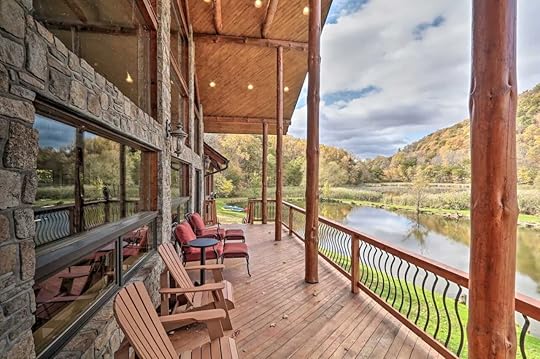
Photo: Airbnb
Skip the city getaway and opt for this serene Airbnb New Jersey mountain getaway. This secluded mountain cabin has everything you need for a fun mountain getaway. This home is perfect for a large family and friends and features a spacious living room with a wood-burning fireplace, ping pong table, poker table, and other games, and the kitchen is fully equipped. There is a 17-acre outdoor area with a 12-acre private pod, furnished deck, paddle boat, canoes, gas grill, and a patio with an outdoor dining experience.
Eight guests, two bedrooms
Price: $300 per night

Photo: Airbnb

Photo: Airbnb
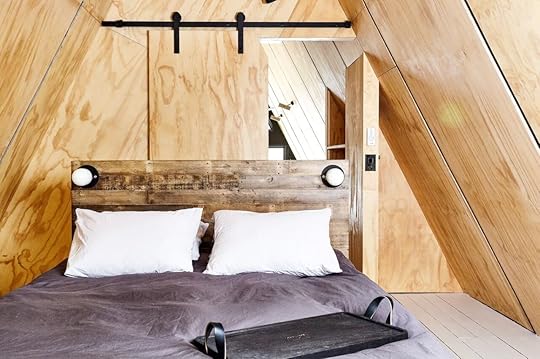
Photo: Airbnb

Photo: Airbnb
Check out this modern A-frame cabin that has modern amenities. This cozy cabin is on a 2.5-acre wooded lot with a private “beach” area in front of the Maurice River. There is an open floor plan that features the kitchen, dining, and living area with large floor-to-ceiling windows. There is a large wrap-around deck with a hot tub, two fire pits, and a charcoal grill.
Eight guests, three bedrooms
Price: $489 per night

Photo: Airbnb

Photo: Airbnb

Photo: Airbnb

Photo: Airbnb
Want to amp it up a notch and experience a bit of luxury while in New Jersey? Well, it’s time to immerse yourself in this luxury five-bedroom villa. This 5,800 square-foot home is the perfect setup for a group of friends or if the whole family is getting together. This home has a full-sized sand volleyball court, basketball court, large in-ground pool, outdoor shower, gazebo on the top and bottom deck, and a paved track in the outdoor space. There are two kitchens, a workspace, and multiple living areas.
Ten guests, five bedrooms
Price: $1,052 per night

Photo: Airbnb

Photo: Airbnb

Photo: Airbnb

Photo: Airbnb

Photo: Airbnb
This custom-built home in Asbury Park features four bedrooms and three and a half bathrooms between three floors. There is a spacious living room with seating for 12, a game room, a dining room, and a kitchen. The outdoor area has a fenced-in backyard with a seven-person hot tub, grill, outdoor shower, lawn games, and multiple seating areas to sit out and relax. 
Fifteen guests, four bedrooms
Price: $1,171 per night
Matador Network's Blog
- Matador Network's profile
- 6 followers



